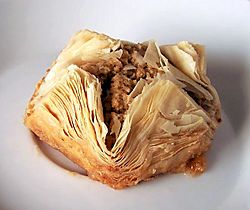Filo facts for kids

Baklava, a sweet treat made with filo pastry
|
|
| Alternative names | Filo pastry, phyllo, fillo |
|---|---|
| Type | Pastry |
| Place of origin | Byzantine-Greek or Ottoman |
| Main ingredients | Flour dough |
Filo (pronounced FEE-loh) or phyllo is a super thin dough. It's used to make yummy pastries like baklava and börek. These treats are popular in the Middle East and Balkan countries. To make them, many thin sheets of filo are stacked. Each sheet is brushed with oil or butter. Then, the pastry is baked until it's golden and crispy!
Contents
What's in a Name?
The name filo or phyllo comes from the Greek word φύλλο, which means 'leaf'. This makes sense because the dough is as thin as a leaf!
In Turkey, this dough is called yufka. This word also means 'thin' and is used for a type of thin, flat bread. In Arabic, it's called reqaqot. In Morocco, it's known as warqa. The Albanian dish flia might even get its name from a word meaning 'sheet' or 'leaf'.
A Sweet History of Filo
No one is completely sure where the idea of stretching dough into super thin sheets first came from. Many cultures believe they invented it!
Some people think the ancient Greeks might have started it. Around 800 BC, the Greek writer Homer mentioned thin breads with walnuts and honey in his famous story, the Odyssey. Later, in the 400s BC, a writer named Philoxenos described a cheesecake. It was made with milk and honey, baked into a pie. This sounds a lot like early filo pastries!
Others believe the Turks were the first. In the 11th century, a book called Dīwān Lughāt al-Turk mentioned a word similar to yufka. It meant "pleated or folded bread." Filo dough was definitely used in the Ottoman Empire, especially at the Topkapı Palace.
How Filo Dough is Made
Filo dough is made from simple ingredients: flour, water, and a little bit of oil. Making filo at home takes a lot of time and skill. You have to roll and stretch the dough until it becomes a single, very thin, and very large sheet.
People often use a big table, sometimes with a marble top, to make it easier. If the dough is stretched by hand, a long, thin rolling pin is used. You have to keep adding flour between the layers so they don't stick together. Today, machines are also used to make filo sheets.
Before World War I, many homes in Istanbul had special filo makers. They would prepare super thin sheets for baklava. They also made slightly thicker sheets for börek. Today, you can buy fresh or frozen filo dough in stores.
Cooking with Filo
When you use filo to make pastries, you stack the thin layers. First, you roll out the dough sheets to their final thinness. Then, you brush each sheet with oil or melted butter. This is different from puff pastry or croissant dough. For those, layers of dough and fat are folded and rolled many times to create a "laminated" dough.
Filo is very versatile! You can use it in many ways:
- Layered
- Folded
- Rolled
- Ruffled
You can fill filo pastries with all sorts of yummy ingredients.
Popular Filo Pastries
Here are some delicious pastries made with filo:
- Baklava – A sweet Ottoman dessert with layers of filo, chopped nuts, and sweet syrup or honey.
- Banitsa – A Bulgarian dish with eggs, cheese, and filo, baked in the oven.
- Börek – A savory Ottoman filo pie, often filled with meat, cheese, or vegetables.
- Bougatsa – A Greek breakfast pastry, usually filled with semolina custard or cheese.
- Bülbül yuvası – A Turkish dessert with pistachios and syrup, shaped like a bird's nest.
- Bundevara – A Serbian sweet pie filled with pumpkin.
- Flia – An Albanian dish with many crêpe-like layers brushed with cream, served with sour cream.
- Galaktoboureko – A Greek dessert with filo and creamy semolina custard.
- Gibanica – A Balkan dish made from filo, white cheese, and eggs.
- Pastizz – A savory pastry from Malta, filled with ricotta cheese or mushy peas.
- Spanakopita – A Greek spinach pie, often with feta cheese.
- Tiropita – A Greek dish similar to Börek, filled with a cheese and egg mixture.
- Zelnik – A savory pie from the Balkans, with various fillings like leeks or cabbage.
See also
 In Spanish: Masa filo para niños
In Spanish: Masa filo para niños

